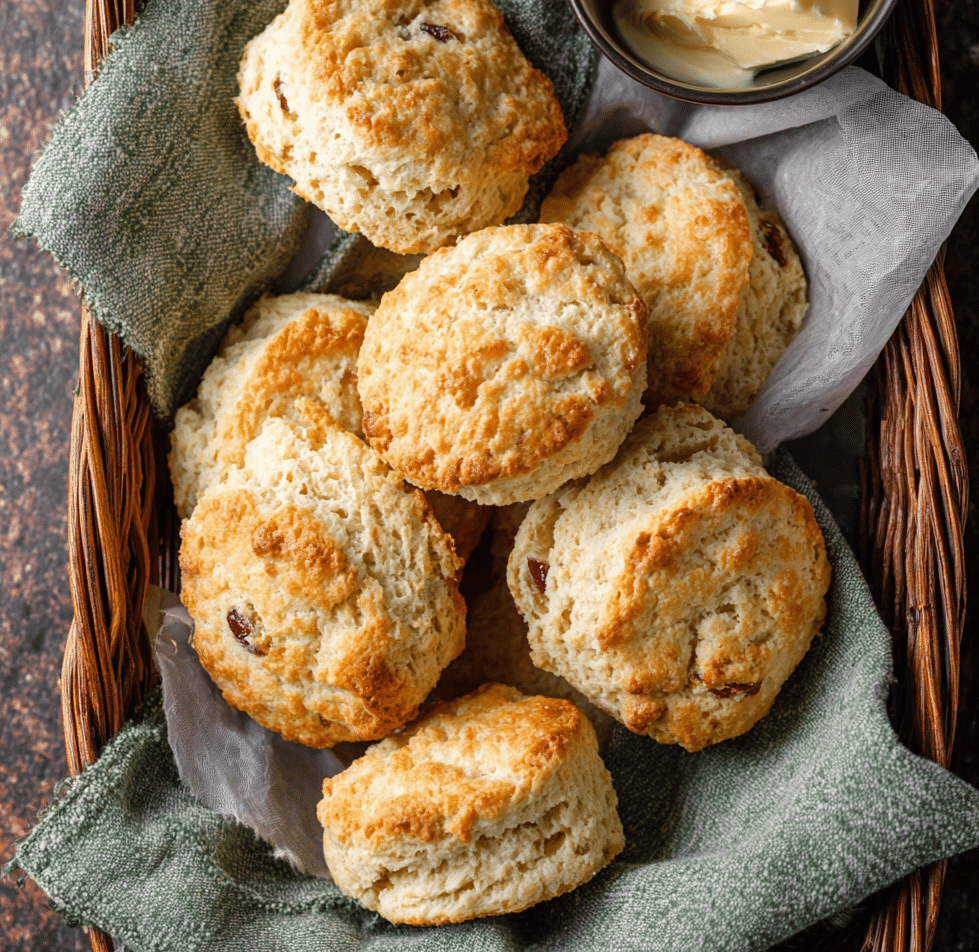The humble Irish scone is more than just a breakfast item—it’s a cherished tradition passed down through generations. These buttery, golden beauties are flaky on the outside with a soft, tender crumb inside, ideal for pairing with sweet jams or rich clotted cream. Their simple preparation and comforting flavor make them a staple in both Irish households and bakeries.
Perfect for brunch spreads, afternoon tea, or a cozy mid-morning snack, Irish scones strike the balance between rustic charm and delicate texture. Whether served plain or with currants, they provide the ultimate canvas for customization while staying true to their roots. Baked to a golden brown and enjoyed warm, they’re an invitation to slow down and savor a timeless tradition.
Full Recipe
Ingredients:
-
2 cups all-purpose flour
-
1 tablespoon baking powder
-
1/4 teaspoon salt
-
1/4 cup granulated sugar
-
5 tablespoons cold unsalted butter, cubed
-
2/3 cup whole milk
-
1 large egg
-
1/2 teaspoon vanilla extract
-
Optional: raisins or currants
Directions:
-
Preheat oven to 425°F (220°C) and line a baking sheet with parchment paper.
-
In a large mixing bowl, whisk together flour, baking powder, salt, and sugar.
-
Cut in the cold butter using a pastry blender or fingertips until the mixture resembles coarse crumbs.
-
In a separate bowl, beat together the milk, egg, and vanilla extract.
-
Pour the wet mixture into the dry ingredients and gently mix until just combined.
-
Turn the dough onto a floured surface and knead lightly until it comes together.
-
Pat the dough to about 1-inch thickness and cut into rounds using a biscuit cutter.
-
Place scones on the prepared baking sheet. Optional: brush tops with additional milk or beaten egg for a golden finish.
-
Bake for 12–15 minutes, or until the tops are golden brown.
-
Let cool slightly before serving with butter, jam, or clotted cream.
Prep Time: 10 minutes | Cooking Time: 15 minutes | Total Time: 25 minutes
Kcal: 210 kcal | Servings: 8 scones
A Deep Dive Into Traditional Irish Scones
Irish scones are a staple of comfort and tradition, often served as part of a classic Irish tea spread or enjoyed freshly baked from a family kitchen. Known for their tender, buttery texture and golden crust, these scones represent more than just a baked good—they’re a cultural symbol, a product of history and simplicity, and a warm, delicious embodiment of Irish hospitality.
Unlike American-style scones which are usually sweet, large, and triangular, Irish scones tend to be round, more subtly flavored, and often less sweet. Their humble appearance hides a richness of taste and texture that make them a beloved classic in households across Ireland and beyond. They can be served plain, dotted with currants or raisins, or elevated with cream and jam for an elegant tea-time treat.
The Heritage Behind Irish Scones
Irish scones have deep roots in the country’s rural history. For generations, Irish families relied on simple pantry ingredients—flour, butter, milk, eggs, and a leavening agent—to create baked goods that were filling, affordable, and satisfying. Because yeast was not commonly used in many parts of Ireland, baking powder became a popular leavening agent, giving rise to the flaky, fluffy scones that are now considered traditional.
These scones were typically made fresh each day and served with tea, becoming a comforting part of daily life and special gatherings alike. The inclusion of ingredients like dried fruits or caraway seeds varied regionally, and many families passed down their own closely guarded recipes. Whether prepared as a quick snack or part of a full tea spread, scones were (and still are) symbols of warmth, nourishment, and togetherness.
Cultural Significance and Modern Popularity
What makes Irish scones so unique and enduring is their ability to bridge the gap between old-world tradition and modern culinary trends. They are now commonly featured in bakeries and cafés around the world, often associated with the charm and refinement of European teatime rituals.
In Ireland and the UK, scones are integral to the beloved ritual of “afternoon tea,” a light meal that typically includes tea, sandwiches, pastries, and of course, scones served with clotted cream and strawberry jam. Even beyond this tradition, the Irish scone has carved out a space in brunch menus, breakfast buffets, and comfort food spreads across the globe.
Their popularity is also boosted by how adaptable they are. Home bakers appreciate that they require no fancy tools or equipment. Variations include adding cheese and herbs for a savory twist, folding in citrus zest or spices, or using buttermilk instead of regular milk for an extra tang. Gluten-free and vegan adaptations are also easy to achieve without sacrificing the scone’s delightful texture and flavor.
Baking Techniques That Make a Difference
The method of making scones is just as important as the ingredients. The signature texture—crisp on the outside and fluffy within—depends on handling the dough with care. Overworking the dough can lead to tough scones, so most recipes emphasize mixing just until combined.
Cold butter is another key to success. It should be cut into the flour mixture to create pockets of fat that melt during baking, resulting in flakiness. The dough should be rolled or patted to an even thickness and cut with a sharp biscuit cutter to ensure clean edges that rise uniformly in the oven.
Bakers also often brush the tops with egg wash or milk to achieve that golden, glossy finish. The baking time is typically short, making this an ideal recipe for last-minute guests or spontaneous tea sessions. Best enjoyed warm from the oven, scones can be stored for a day or two but are rarely around long enough to require that.
Serving Suggestions and Pairings
One of the best things about Irish scones is how versatile they are when it comes to serving. The classic presentation involves a warm scone split in half and topped with a generous dollop of clotted cream and jam. Strawberry or raspberry jam are traditional favorites, but other variations like lemon curd, honey, or even butter also pair beautifully.
Scones are commonly served with a pot of hot tea—typically Irish breakfast tea or a black blend with milk. For a more modern brunch experience, they can be paired with fresh fruit, yogurt, or even scrambled eggs and cheese. When served alongside savory ingredients, they become a hearty, comforting addition to any meal.
Hosting a tea party or brunch? Consider offering a variety of scone flavors and fillings—plain, fruit-studded, and cheese-herb varieties—to suit different palates. With their neutral base and delicate flavor, Irish scones can easily be customized and paired with either sweet or savory spreads.
Why Irish Scones Stand the Test of Time
There’s a reason Irish scones have remained a cherished baked good across generations. They’re simple, accessible, quick to prepare, and incredibly satisfying to eat. The contrast of textures—the tender crumb inside and the crisp, golden edges—is part of their universal appeal. They are unpretentious, but when done right, they’re absolutely irresistible.
Beyond flavor, they carry an emotional resonance. For many, baking or eating scones brings back memories of home kitchens, family gatherings, or quiet mornings with a hot cup of tea. Their versatility makes them suitable for both everyday indulgence and special occasions, whether enjoyed solo or served to guests.
Scones also reflect the best of Irish culinary traditions: practical, resourceful, and grounded in family heritage. They show that a few simple ingredients, combined with love and skill, can result in something truly special.
Conclusion
Irish scones are far more than just a breakfast or teatime snack—they are a celebration of tradition, flavor, and warmth. Their rich history, simple preparation, and comforting taste make them a timeless favorite in kitchens around the world. Whether you serve them plain with butter, paired with cream and jam, or adapted with your favorite ingredients, they offer a baking experience that’s both nostalgic and rewarding.
Including Irish scones in your culinary repertoire is not just about learning a recipe; it’s about embracing a piece of cultural heritage that continues to bring joy and connection to every table. Whether you’re a seasoned baker or a kitchen novice, once you make a batch of these delightful treats, they’re sure to become a cherished part of your own baking tradition.






